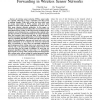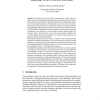104 search results - page 19 / 21 » Nodes of large degree in random trees and forests |
GLOBECOM
2010
IEEE
13 years 6 months ago
2010
IEEE
In wireless sensor networks (WSNs), sensor nodes are typically subjected to energy constraints and often prone to topology changes. While duty cycling has been widely used for ener...
CORR
2010
Springer
13 years 8 months ago
2010
Springer
Abstract. We present the discrete beeping communication model, which assumes nodes have minimal knowledge about their environment and severely limited communication capabilities. S...
SPAA
2004
ACM
14 years 2 months ago
2004
ACM
In this paper, we examine the problem of large-volume data dissemination via overlay networks. A natural way to maximize the throughput of an overlay multicast session is to split...
BIBM
2008
IEEE
14 years 3 months ago
2008
IEEE
Network alignments are extensively used for comparing, exploring, and predicting biological networks. Existing alignment tools are mostly based on isomorphic and homeomorphic embe...
ICRA
2003
IEEE
14 years 1 months ago
2003
IEEE
- Moving a crowd of robots or avatars from their current configurations to some destination area without causing collisions is a challenging motion-planning problem because the hig...



